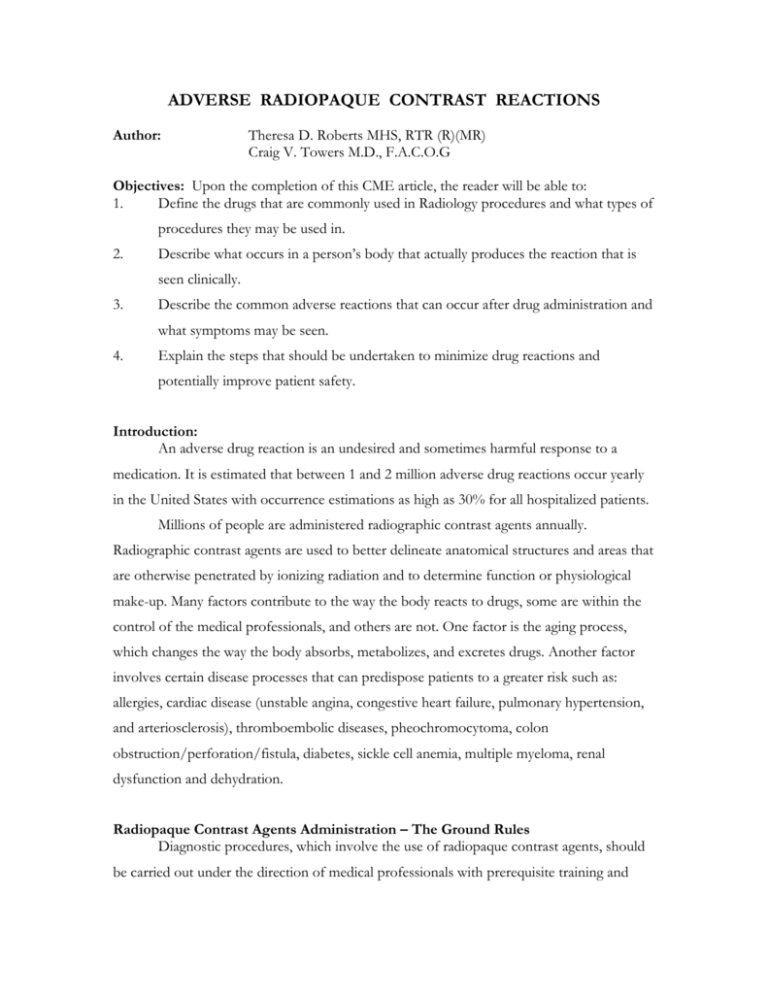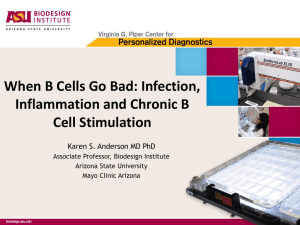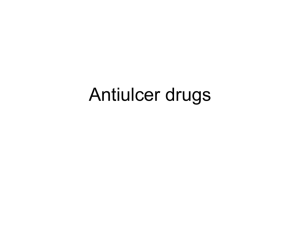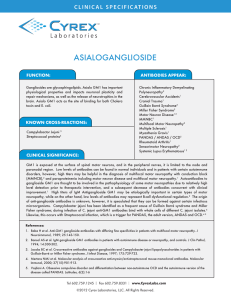ADVERSE CONTRAST MEDIA REACTIONS - e
advertisement

ADVERSE RADIOPAQUE CONTRAST REACTIONS Author: Theresa D. Roberts MHS, RTR (R)(MR) Craig V. Towers M.D., F.A.C.O.G Objectives: Upon the completion of this CME article, the reader will be able to: 1. Define the drugs that are commonly used in Radiology procedures and what types of procedures they may be used in. 2. Describe what occurs in a person’s body that actually produces the reaction that is seen clinically. 3. Describe the common adverse reactions that can occur after drug administration and what symptoms may be seen. 4. Explain the steps that should be undertaken to minimize drug reactions and potentially improve patient safety. Introduction: An adverse drug reaction is an undesired and sometimes harmful response to a medication. It is estimated that between 1 and 2 million adverse drug reactions occur yearly in the United States with occurrence estimations as high as 30% for all hospitalized patients. Millions of people are administered radiographic contrast agents annually. Radiographic contrast agents are used to better delineate anatomical structures and areas that are otherwise penetrated by ionizing radiation and to determine function or physiological make-up. Many factors contribute to the way the body reacts to drugs, some are within the control of the medical professionals, and others are not. One factor is the aging process, which changes the way the body absorbs, metabolizes, and excretes drugs. Another factor involves certain disease processes that can predispose patients to a greater risk such as: allergies, cardiac disease (unstable angina, congestive heart failure, pulmonary hypertension, and arteriosclerosis), thromboembolic diseases, pheochromocytoma, colon obstruction/perforation/fistula, diabetes, sickle cell anemia, multiple myeloma, renal dysfunction and dehydration. Radiopaque Contrast Agents Administration – The Ground Rules Diagnostic procedures, which involve the use of radiopaque contrast agents, should be carried out under the direction of medical professionals with prerequisite training and thorough knowledge of the appropriate protocol for the procedure to be performed. All orders must be closely checked and questioned when unclear or if they seem to be inappropriate. Radiology professionals are mandated to act as a patient advocate. Simply administering contrast agents “because the doctor ordered it that way” or “because it is the protocol” does not serve as a legal defense if the patient experiences a negative outcome. The radiology professional is responsible for being knowledgeable regarding the appropriate dosage, integrity of the contrast medium, and indications for the radiopaque agent administered. Drugs Routinely Administered During Radiology Procedures: Diatrizoate Meglumine: Aqueous solution for pre-enteral use. This radiopaque agent is indicated in excretion urography, cerebral/peripheral arteriography, venography, operative T-tube or percutaneous transhepatic cholangiography, splenoportography, arthrography, discography and computerized tomography as an enhancement agent. Diatrizoate Sodium: Palatable water-soluble iodinated contrast medium for oral or rectal administration. Administration of this medium is indicated for radiographic segments of the gastrointestinal tract (esophagus, stomach, proximal small intestine and colon). This agent may also be used as an adjunct to contrast enhancement in computed tomography of the torso (body imaging). Iopamidol: Stable aqueous, non-pyrogenic solutions for intravascular administration. Iopamidol injections may be used for angiography throughout the cardiovascular system including cerebral and peripheral, coronary arteriography, ventriculography, pediatric angiocardiography, selective visceral arteriography, aortography, peripheral venography and adult/pediatric intravenous excretory urography. Also indicated for use of adult and pediatric contrast enhancement of computerized tomography of head and body imaging. Barium Sulfate: Insoluble material which, because of its density, provides a positive contrast medium. Barium sulfate is an inert radiopaque material that is not absorbed or metabolized and is eliminated intact from the body in a manner similar to other non-absorbed inorganic materials. Barium Sulfate, based on it consistency, may be administered as an oral or rectal radiopaque medium for use in imaging the intestinal tract. Glucagon: Polypeptide hormone identical to human glucagon that increases blood glucose and relaxes smooth muscle of the gastrointestinal tract. Administered through a parenteral route, Glucagon relaxes the smooth muscle of the stomach, duodenum, small bowel, and colon. Gadopentetate Dimeglumine: Injectable contrast medium for magnetic resonance imaging (MRI). Gadopentetate Dimeglumine is to be administered by intravenous injection. It is a paramagnetic agent and as such, it develops a magnetic moment when placed in a magnetic field. Therefore, the indication for use is in MRI to provide contrast enhancement in those intracranial lesions with abnormal vascularity, lesions causing abnormality in the blood brain barrier or to facilitate visualization of lesions in the spine and associated tissues. Gadoteridal: Nonionic contrast medium for Magnetic Resonance Imaging. This MRI contrast agent is also paramagnetic. Using an injection of Gadoteridal provides contrast enhancement of the brain, spine, and surrounding tissues resulting in improved visualization of lesions with abnormal vascularity, lesions causing abnormality in the blood brain barrier or to facilitate visualization of central nervous system lesions including but not limited to tumors. What Actually Produces the Adverse Drug Reactions that are Seen Clinically? Adverse drug reactions in a person’s body can occur from an immunologic process or through non-immunologic responses. The immunologic reaction involves antibodies that are normally produced by the body. In general terms, the human body has a group of cells that belong to the immune system. The basic cells are labeled T-cells and B-cells. The T-cells are further broken down into T-4 cells and T-8 cells. The T-4 cell (which usually accounts for about 70% of the T-cell population) is called the helper-inducer cell and is the “captain” of the ship. This cell is responsible for identifying substances that do not normally belong in the body, such as viruses, bacteria, pollens, and drugs or medications, etc. When the T-4 cell identifies one of these substances, it “activates” the immune system by informing the T-8 cells and the B-cells. The B-cells actually produce the antibodies or immunoglobulins that are found in our bodies. The primary antibodies that are formed are IgM, IgG, IgA, and IgE. The T-8 cells (which account for the remaining 30% of the T-cell population) are called the killer-suppressor cells. The best way to explain this system is by using an example. Lets assume a cold virus infects you. The T-4 cell identifies this virus and determines that it does not belong in your body. In the meantime, this virus is replicating and causing cells to die, which releases substances that damage the area and produce the symptoms that are seen in the sites that are infected, i.e. the nose, throat, and bronchial tree when using the common cold as an example. The T-4 cells, however, have activated the T-8 cells to kill the virus and have turned on the B-cells to produce antibodies against it. In a few days, your body has enough defenses to ultimate kill the virus and you eventually get better. Not to belabor this point, however, the human immunodeficiency virus (HIV) primarily infects T-4 cells. As you can see from this discussion, people infected with HIV develop numerous problems because the “captain” of the immune system is rendered dysfunctional. As stated in the preceding paragraph, as cells die, substances are released into the body that produce further reactions and symptoms. Some of these substances include histamine, cytokines, platelet-activating factor, prostaglandins, tumor necrosis factor, and enzymes. When a drug produces a typical allergic reaction through the immune system, it usually involves IgE or IgA antibodies. These antibodies may be found on the surface of sensitized cells and when exposed to the drug, will result in the release of these chemicals. IgE-dependent drug reactions can be immediate or accelerated. The “immediate” reactions usually occur within minutes and can include itching (pruritus), rashes, nausea, vomiting, laryngeal edema, bronchospasm, hypotension, shock (anaphylaxis, described in more detail below) and even death. “Accelerated” reactions occur hours to days after the drug is administered and usually involve urticaria (hives) and occasionally laryngeal edema. One other type of immune related drug reaction is the immune-complex or serum sickness process. This is rare and is primarily seen with drugs that remain in the body for prolonged periods or drugs that are taken by an individual over a period of time. This usually involves IgG antibodies. The symptoms of this reaction are fever, arthritis, nephritis, urticaria, edema, and neuritis. Drugs that have been associated with serum sickness are the penicillins, the sulfonamides, cholecystographic dyes, thiouracils, and phenytoin. Drug reactions can also produce a response through non-immunologic means. Some of the ways this can occur are: By direct release of irritating substances from certain cells in the body. By interaction with other drugs. Through exacerbating a pre-existing condition in the person. Through cumulative effects and overdosage. Non-immunologic drug reactions are actually responsible for the majority of drug reactions that occur. Some drugs may cause the direct release of histamine, cytokines, and enzymes from cells without the help of antibodies. This is another pathway for the development of anaphylaxis. This is also a common cause for urticaria or hives. Drugs that commonly produce hives include narcotics, radiocontrast media, and some antibiotics. Drugs may also cause direct reactions by interfering with certain enzyme pathways, either through stimulation or inhibition. The common ways in which drugs can interact with each other is by competing for the same binding sites on certain cells found in various organs (which results in an overall decrease in function by the drug), by stimulating enzymes that metabolize another drug more quickly, or by inhibiting how quickly the kidneys excrete a drug. Some drugs may exacerbate a pre-existing condition in a patient. For instance, medications used for one function may also produce another response as a side effect. For example, some decongestants can increase a person’s blood pressure, which may not be good for a person with cardiovascular disease or diabetes. In addition, since drugs can produce an immunologic response in some people, individuals with immune related diseases, such as Lupus or Rheumatoid Arthritis, should also be cautious. Finally, some medications can have an accumulative effect. Again, this is uncommon for radiocontrast material and usually requires prolonged use or multiple doses. Some examples for this type of reaction include some chemotherapy drugs or prolonged usage and exposure to mercury, silver, or gold. Adverse Reactions The possibility of a reaction (mild to severe) should always be considered. Patients may not react by having all of the symptoms listed below. The degree of severity and type of onset is patient dependent. Patients with known or questionable histories of sensitivity to radiopaque contrast agents may be given a pre-medication to minimize the risk of reaction. The most common pre-treatment regiments employ the use of either a corticosteroid (such as prednisone) or antihistamines (such as diphenhydramine, i.e. Benadryl). When contrast agents, especially diatrizoate meglumine or diatrizoate sodium are administered (organically bound iodine), the crash cart should be on hand. To minimize the risk of acute renal failure (ARF) careful attention should be paid to the patient’s hydration status, before, during and after the diagnostic procedure. Type of Adverse Reaction Symptoms: Cardiovascular Reactions can be varied. Peripheral vasodilatation can occur, which decreases systemic blood pressure (hypotension), which in turn causes a reflex tachycardia (rapid heart rate or pulse). Sometimes vasoconstriction can occur resulting in an increase in blood pressure (hypertension) that may result in a slowing of the heart rate (bradycardia). The heart itself can be directly affected producing arrhythmias (i.e. ventricular fibrillation), myocardial ischemia and angina pectoris (chest pain), and even complete circulatory collapse. If a bradycardia occurs, this can result in fainting or blacking out. Because many agents are administered intravenously, sometimes there can be direct injury to the blood vessel resulting in thrombophlebitis. Nervous System Reactions can present as pain, a burning sensation, or a tingling in an extremity. The vagus nerve can also sometimes be stimulated producing a vasovagal reaction with bradycardia and syncope. Digestive System Reactions involve nausea, vomiting, and anorexia. Respiratory Tract Reactions include bronchial constriction, which results in tachypnea (rapid breathing) and dyspnea (shortness of breath). Severe cases can result in pulmonary edema. Skin Reactions are common and include rashes, urticaria (hives), pruritus (itching), and flushing (redness of the skin). Special Senses can be altered producing taste alterations, nasal congestion, visual disturbances, a feeling of warmth and or a feeling of being cold. Other Body Reactions may include hot flashes, headache, fever, chills, and excessive sweating. Anaphylactic Reactions Anaphylaxis is a severe hypersensitivity reaction to a causative agent or agents. Anaphylactic reactions cause large quantities of histamine to be released, which in turn causes an increase in capillary permeability and widespread dilation of arterioles and capillaries. Another organ that can be affected is the respiratory system resulting in severe shortness of breath. Other symptoms can include facial and/or laryngeal edema, fainting, itching, and urticaria (hives). One of the treatments for this disorder is epinephrine, which constricts the dilated blood vessels and helps to dilate the bronchial tree. Some of the other symptoms can be treated with an antihistamine such as Benadryl. The “5” Rights Be sure to have the “right” (1) patient, (2) medication, (3) route, (4) dosage, and (5) monitoring. If that is followed, what is left to worry about? The radiographer should (1) identify allergy histories and make a list of drugs or foods that the patient is allergic to with a description of the “reaction” that occurred; (2) identify incompatibilities – for example: patients taking glucaphage (a prescription drug for diabetic patients) who are scheduled for a radiographic procedure that requires administration of either glucagon or diatrizoate meglumine or diatrizoate sodium should consult with a physician before administering; (3) correctly prepare the agent to be administered; (4) perform adequate monitoring after the drug is administered; and (5) educate the patient regarding the administration of drugs for the procedure(s) they are about to undergo. Reminders Carefully look at drug labels and be mindful of expiration dates. Use prescribed directions for making solutions. Avoid contamination of sterile agents. Always remember to confirm IV functioning or tube placement before administering agents. Observe the recommended administration dose and/or injection rates. Remember that every administration of a radiopaque contrast agent has the potential to cause an anaphylactic reaction, even if the patient has received contrast in the past with no reported adverse effect. Acknowledgments: Susanne J. Danis RN, MSN, ARNP-C References or Suggested Reading: 1. Bloget, J. B. (1995) Managing Injection Reaction. Nursing 95, 15, (9), 46-47. 2. Edward, J. (1997). Guarding Against Adverse Drug Events. American Journal for Nurses, (5) 26-30. 3. Kostecky, J. (1996). Rx Update. Hospital Physician, 1996, 51. 4. Kostecky, J. (1996). Rx Update. Hospital Physician, 1997, 56-71. 5. Kuhn, M. A. (1998). Drug Interactions with Medications and Food. Nursing Spectrum (12), 12-14. 6. Salerno, E. (1993). Mosby’s Pharmacology Update, Spring 1993. 7. Arndt KA, Jick H. (1976) Rates of Cutaneous reactions to drugs. JAMA (235), 918. 8. Parker CW. (1975) Drug Allergy. New England Journal of Medicine (292), 511. 9. Greenberger PA. (1984) Contrast Media Reaction. J Allergy Clinical Immunology (74) 600. 10. Pasricha JS. (1979) Drugs Causing Fixed Eruptions. British Journal of Dermatology (100), 183. About the Authors: Theresa D. Roberts, MHS, RT(R)(MR), graduated from Quinnipiac College with a Master in Health Sciences. She is a Registered Radiologic Technologist specializing in magnetic resonance imaging and is employed as the Imaging Systems Manager at Hollywood Medical Center. She completed her undergraduate studies at New Hampshire College receiving a Bachelors of Science in Human Resources. She then attended South Central Community College receiving her Associates of Science in Radiologic Technology. She has 10 years experience as an educator and prior to her management position, held the position of Assistant Professor of Radiologic Sciences at Quinnipiac College and Miami-Dade Community College. Dr. Towers is currently on a sabbatical writing a series of books that deal with the safety of over-the-counter drugs, herbal medications, and natural remedies used during pregnancy. The first is in print entitled “I’m Pregnant & I Have a Cold – Are Over-theCounter Drugs Safe to Use?” published by RBC Press, Inc. Before his sabbatical, Dr. Towers was an Associate Professor in the Department of Obstetrics and Gynecology at the University of California, Irvine. He also was the Director of Perinatal Medicine at Long Beach Memorial Women’s Hospital in Long Beach California. He has practiced clinically in the states of Kansas, California, and Wisconsin. Dr. Towers has multiple publications in peer review medical journals and he has given lectures on a wide variety of obstetrical topics nationwide. Examination: 1. An adverse drug reaction is an undesired and sometimes harmful response to a medication. It is estimated that between _________ adverse drug reactions occur yearly in the United States. A. 10 and 20 thousand B. 100 and 200 thousand C. 1 and 2 million D. 10 and 20 million E. 100 and 200 million 2. The aging process A. does not change the way the body absorbs a drug B. makes things less complicated when administering radiographic contrast agents C. does not change the way the body metabolizes a drug D. changes the way the body excretes drugs E. is not an issue regarding the administration of radiologic contrast agents 3. All of the following disease processes can predispose patients to a greater risk when administering radiographic contrast agents EXCEPT A. cardiac disease B. pheochromocytoma C. history of allergies D. diabetes E. aplasia cutis congenita 4. Which of the following statements is FALSE? A. Diagnostic procedures, which involve the use of radiopaque contrast agents, should be carried out under the direction of medical professionals with prerequisite training and thorough knowledge of the appropriate protocol for the procedure to be performed. B. All orders must be closely checked and questioned when unclear or if they seem to be inappropriate. C. Radiology Professionals are not mandated to act as a patient advocate. Administering contrast agents “because the doctor ordered it that way” or “because it is the protocol” could serve as a legal defense if the patient experiences a negative outcome. D. The radiology professional is responsible for being knowledgeable regarding the appropriate dosage for the radiopaque agent administered. E. The radiology professional is responsible for being knowledgeable regarding the integrity of the contrast medium and indications for the radiopaque agent administered. 5. Which of the following radiographic contrast agents would most likely be used for pediatric angiocardiography? A. Diatrizoate Meglumine B. Iopamidol C. Glucagon D. Gadopentetate Dimeglumine E. Gadoteridal 6. Which of the following radiographic contrast agents would most likely be used to relax the smooth muscle of the stomach, duodenum, small bowel, and colon? A. Diatrizoate Meglumine B. Iopamidol C. Glucagon D. Gadopentetate Dimeglumine E. Gadoteridal 7. Which of the following radiographic contrast agents would most likely be used for Magnetic Resonance Imaging to enhance the brain, spine, and surrounding tissues? A. Diatrizoate Meglumine B. Iopamidol C. Glucagon D. Barium Sulfate E. Gadoteridal 8. Which of the following statements is true? A. In general terms, the human body has a group of cells that belong to the immune system. The basic cells are labeled IgG and IgM. B. T-4 cells are called the killer-suppressor cells. C. The B-cells actually produce the antibodies or immunoglobulins that are found in our bodies. D. The T-8 cell is called the helper-inducer cell and is the “captain” of the ship. E. Regarding cell distribution, the T-8 cells account for 70% of the T-cell population and the T-4 cells account for the remaining 30%. 9. When cells die, substances are released into the body that produce further reactions and symptoms. These may include all of the following EXCEPT A. histamine B. cytokines C. platelet-activating factor D. prostaglandin E. thyroglobulin 10. Which of the following statements is true? A. When a drug produces a typical allergic reaction through the immune system it usually involves IgM antibodies. B. IgE-dependent drug reactions can be immediate or accelerated. C. D. E. The “immediate” reactions occur hours to days after the drug is administered and usually involve urticaria and occasionally laryngeal edema. “Accelerated” reactions usually occur within minutes and can include itching, rashes, nausea, vomiting, bronchospasm, shock and even death. When a drug produces a typical allergic reaction through the immune system, it usually involves IgG antibodies. 11. Some of the ways a drug can produce a response through non-immunologic means include all of the following EXCEPT A. By direct release of irritating substances from certain cells in the body. B. Through cumulative effects and overdosage. C. Through exacerbating a pre-existing condition in the person. D. By activating the IgE immune system. E. By interaction with other drugs. 12. Which of the following statements is true? A. Non-immunologic drug reactions are actually responsible for the majority of drug reactions that occur. B. Some drugs may cause the release of histamine, cytokines, and enzymes from cells but they always need the help of antibodies. C. The common ways in which drugs can interact with each other is by directly binding together, thereby producing a stronger substance. D. Fortunately, drugs will not interfere with enzyme pathways. E. Though drugs can produce an immunologic response, patients with lupus or rheumatoid arthritis have no higher concern than the general population. 13. Regarding adverse reactions, which of the following statements is true? A. The possibility of a reaction (mild to severe) should always be considered. B. The degree of severity and the type of onset is not patient dependent. C. Patients with known or questionable histories of sensitivity to radiopaque contrast agents should not be given a pre-medication to minimize the risks because they may react to the pre-medication. D. Unfortunately, there is no way to minimize the risk of acute renal failure following the administration of a contrast agent. E. For patients with a known history of sensitivity to radiopaque contrast agents, they should be pre-medicated with ampicillin to minimize the risks. 14. Examples of cardiovascular reactions include all of the following EXCEPT A. hypotension B. hypertension C. tachycardia D. tingling in an extremity E. angina pectoris 15. Nervous system reactions can include all of the following EXCEPT A. a burning sensation B. a tingling sensation in an extremity C. pain D. E. excessive sweating vasovagal reaction of the vagus nerve 16. Respiratory tract reactions may include A. anorexia B. bronchial constriction C. urticaria D. taste alterations E. a feeling of warmth 17. Anaphylaxis is a severe hypersensitivity reaction to a causative agent or agents. Which of the following statements is true? A. Anaphylactic reactions cause large quantities of histamine to be released, which in turn causes an increase in capillary permeability B. Anaphylactic reactions cause large quantities of histamine to be released, which in turn causes widespread constriction of arterioles and capillaries. C. Another organ that can be affected is the nervous system resulting in severe shortness of breath. D. One of the treatments for this disorder is epinephrine, which dilates the constricted blood vessels and helps to constrict the bronchial tree. E. Some of the symptoms can be treated with a decongestant such as Benadryl. 18. All of the following statements are true EXCEPT A. The radiographer should identify allergy histories and make a list of drugs or foods that the patient is allergic to with a description of the “reaction” that occurred. B. The radiographer should identify incompatibilities. C. The radiographer should correctly prepare the agent to be administered. D. The radiographer should perform adequate monitoring after the drug is administered. E. The radiographer should obtain the drug from the pharmacy in person. 19. All of the following statements are true EXCEPT A. The patient should be educated regarding the administration of drugs for the procedure(s) they are about to undergo. B. Because radiographic contrast agents are bacteriostatic, use of sterile technique is not indicated. C. Carefully look at drug labels and be mindful of expiration dates. D. Always remember to confirm IV functioning before administering agents. E. Always remember to confirm tube placement before administering agents. 20. All of the following statements are correct EXCEPT A. The administration of a radiopaque contrast agent can only cause an anaphylactic reaction if the patient has received the contrast in the past. B. Observe the recommended dosage prior to drug administration. C. Observe the recommended drug injection rates. D. Use prescribed directions for making solutions E. It is important to avoid contamination of sterile agents






